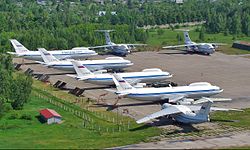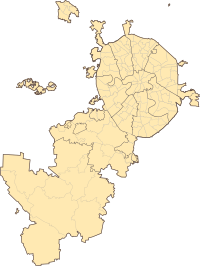This article has multiple issues. Please help improve it or discuss these issues on the talk page. (Learn how and when to remove these messages)
|
Chkalovsky (IATA: CKL[2], ICAO: UUMU[1]) is a military air base near Shchyolkovo, Moscow Oblast, Russia. It is located 31 km northeast of Moscow.[citation needed]
Chkalovsky Чкаловский | |||||||||||
|---|---|---|---|---|---|---|---|---|---|---|---|
 Satellite imagery of Chkalovsky air base | |||||||||||
 | |||||||||||
| Summary | |||||||||||
| Airport type | Military | ||||||||||
| Owner/Operator | Russian Aerospace Forces | ||||||||||
| Serves | Moscow | ||||||||||
| Elevation AMSL | 499 ft / 152 m | ||||||||||
| Coordinates | 55°52′42″N 38°03′42″E / 55.87833°N 38.06167°E | ||||||||||
| Map | |||||||||||
 | |||||||||||
| Runways | |||||||||||
| |||||||||||
Source: Aviapages.ru[1] | |||||||||||
The airport name is also given as Chkalovskoye. The facility should not be confused with Kaliningrad Chkalovsk or Omsk Chkalovsk airfields.
History
editIn 1929, a decision was made to create a new flight test base of Soviet significance near Moscow. The largest runway of reinforced concrete slabs in the Union of Soviet Socialist Republics was built here. wind tunnels, hypobaric chambers, special scales for weighing aircraft, a research plant and other scientific and testing facilities were also built. A little later, a launch slide was built here (the first prototype of a springboard take-off runway for aircraft carriers), which was popularly called "Chkalovskaya". It was needed for the launch of heavy aircraft, primarily of the experimental ANT-25 (RD).[3]
In 1932-35, the state flight testing institute was relocated here from Khodynka, the Central Airfield. A reorganisation in December 1960 saw most testing arrangements moved to Akhtubinsk in Astrakhan Oblast.
After the German Operation Barbarossa invasion began in 1941, three fighter aviation regiments (401, 402, 403), two dive bomber regiments (410, 411), two heavy bomber regiments (420, 421), an assault regiment (430), a reconnaissance squadron, as well as three airfield service battalions (760,761,762) were formed at Chkalovsky.
The base provides air support for Star City, Yuri Gagarin Cosmonauts Training Center, and other elements of the Soviet space program and Russian Federal Space Agency. It is also a major transport base, with the 8th Special Purpose Aviation Division (since 2009–10, the 6991st Air Base) operating the Antonov An-12, Antonov An-72, Tupolev Tu-154, Ilyushin Il-76, and Il-86VKP. Chkalovsky received USSR's first Il-76K for cosmonaut training on 23 July 1977.
On 27 March 1968, while on a routine training flight from the base, Yuri Gagarin and flight instructor Vladimir Seryogin died when their MiG-15UTI crashed near the town of Kirzhach. The bodies of Gagarin and Seryogin were cremated and their ashes interred in the walls of the Kremlin.[4] Wrapped in secrecy, the cause of the crash that killed Gagarin is uncertain and became the subject of several theories, including several conspiracy theories.[5][6]
On 18 September 2023, the Ukrainian military intelligence claimed that they had raided Chkalovsky Air Base. According to them, the raid damaged or destroyed an An-148, an Ilyushin Il-20, and a Mil Mi-28 helicopter.[7]
See also
editReferences
edit- ^ a b "ЧКАЛОВСКИЙ (ИКАО: УУМУ) / CHKALOVSKY (ICAO: UUMU)" (in Russian). Aviapages.ru. Retrieved 10 March 2010.
- ^ Accident history for CKL at Aviation Safety Network
- ^ "History Chkalovsky Aerodrome". Schelkovsky Historical and Regional Museum (in Russian). Archived from the original on 2016-09-19. Retrieved 2016-08-05.
- ^ Cavallaro 2018, p. 248
- ^ Holt, Ed (3 April 2005). "Inquiry promises to solve Gagarin death riddle". Scotland on Sunday. Archived from the original on 15 April 2008. Retrieved 30 March 2008.
- ^ Osborn, Andrew (September 2010). "What made Yuri fall?". Air & Space. Archived from the original on 19 September 2010. Retrieved 24 September 2010.
- ^ Jake Epstein (2023-09-20). "Saboteurs 'blew up' aircraft at a Russian base in the latest in a string of attacks, causing 'hysteria,' Ukrainian military intelligence reports". Business Insider. Retrieved 2023-09-21.
- Cavallaro, Umberto (5 October 2018). The Race to the Moon Chronicled in Stamps, Postcards, and Postmarks: A Story of Puffery vs. the Pragmatic. Chichester, UK: Praxis Publishing. ISBN 978-3-319-92153-2.
